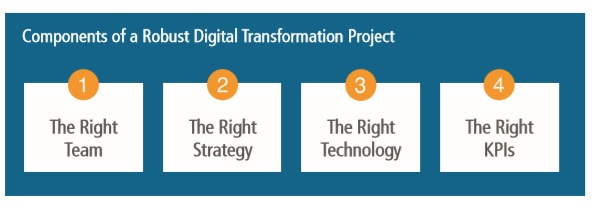Digital transformation is an innovative way that enterprises can use technology and data to develop a business ecosystem. It is more than moving from paper to glass, and can reduce risk, accelerate modernization, and drive growth.
The term “digital transformation” attracts a lot of hype. No wonder: the modern gleam of digital and the big-picture promise of that word transformation are irresistible. So much of that hype is based on speculation and inflated claims, though.
John Heiser, CEO, LabVantage Solutions Inc.
Deconstructing the Term ‘Digital Transformation’
Prior digital movements only began to explore inefficiency, but the transformation witnessed currently investigates it on a whole new level. The main idea involves using technology to unblock the flow of data through an organization. This gives entrepreneurs and the leaders in business a 360 degree view that they need in order to recognize patterns and trends, eradicate bottlenecks, isolate risks, and expose hidden opportunities for innovation.
A strong digital transformation strategy is directly influenced by a company’s business aims. However, the most successful businesses have several important attributes in common:
- It has winners at the top and for it to succeed, it needs the active support of an innovative CEO and an executive leadership team that wants to embrace expertise from an outside source and empower those in transformational positions.
- Its main objective is interconnection and it supports the unobstructed flow of data throughout the whole organization. It arranges tools to help visualize and interrogate the data. This strategy improves harmonization and standardization across all inside teams and enables efficiency and pipeline growth.
- It is clear enough to induce forward action, then flexible enough to adapt and scale. Effective strategies are advanced in response to the competitive market today, as well as to secure against future risks. Businesses need built-in agility in response to ever-changing needs and opportunities. This is possibly true most commonly in lab environments, where integrated LIMS, ELN, and LES functions permit reliability without limiting flexibility.
Transformation Begins at the Top
For a digital transformation strategy to be successful, it is imperative that there is harmony between executives, IT, and on-the-ground operations. To accomplish harmony, companies should plan who gets to sit at the decision-making table. Internal professionals with first-hand knowledge and expertise on specific organizational realities can be used as a guide.
CIOs seeking to build and expand a digital business should work with each senior executive to quantify the extent to which their areas would benefit from digitalization. For example, work with a COO to define how much of their manufacturing operations should be digitalized and what benefits to expect.
Gartner, Digital Business KPIs: Defining and Measuring Success, James Anderson and Paul Proctor
What is at Stake?
In 2019, IDC has stated that investing in digital transformation projects will surpass $2 trillion and 40% of all technology expenses will be used for technologies that support these projects.1
The Question is: Why?
The main promise encouraging this increase in investment is profitable top-line revenue growth. This is made possible through developing improvements that differ between organizations. These may include:
- Higher throughput: Companies with higher digital sophistication see an increase in efficiency, performance, and scalability. They concentrate on speed across the whole development lifecycle of the company; from R&D to product release, and they utilize data-driven insights and develop that speed into pipeline growth.
- Lowered risk: In today’s world of complex product analysis, errors can result in a high price. Those errors are most common when one process interacts with another, requiring data to leap across systems. Digital transformation projects result in seamless interaction between systems which limit possibilities for costly mistakes.
- Sustained regulatory compliance: A digital strategy that backs up continuing transparency and compliance is more important now than ever with data becoming more complex and regulators focusing on industries not accustomed to heavy oversight. For example, food and beverage manufacturing.
- Improved quality: With the combination of a lower number of functional silos with a centralized data source enabling oversight, senior leaders have a better indication of constant patterns across the organization. This results in companies being able to proactively look at and solve problems and utilize enhanced processes from one area into another, supporting quality as a whole.
Planning for a Successful Digital Transformation

Figure 1: Components that make up a Robust Digital Transformation Project. Image Credit: LabVantage Solutions
Start with the Correct Team
A successful digital transformation strategy is dependent upon an organization’s ability to balance the perspective of inside experts (staff with frontline knowledge of the interdependent systems undergoing transformation) as well as external resources (experts with both domain experience and a record of sustained technological innovation).
A visionary executive leadership team should oversee these complementary groups, propelling forward momentum and building a corporate culture that welcomes dramatic organizational change.
An innovative executive leadership team should be there to manage these complementary groups in order to propel momentum forward and create a corporate culture that will be able to cope with increased organizational change.
Who Should Help Define your Digital Transformation Strategy?
- The highest leadership team and their board of governors
- Employees with a “transformation related” role, like the CIO and the IT team
- External advisors, technology associates, and trusted consultants
How Does LabVantage Enable Digital Transformation Teams?
Across multiple industries, experts work at the intersection of technical sophistication and domain-specific knowledge. LabVantage works closely with executive teams to further develop transformational initiatives together that begin with the lab and contribute to the enterprise-wide success of end-to-end digital transformation strategies.
References
- Pucciarelli, Joseph, “4 Things Successful CIOs Know About Digital Transformation.” CIO Magazine. Winter 2018; 17. Web. 22 Oct. 2019. https://images.idgesg.net/assets/2018/01/state_of_the_cio_01_ciod_winter_final.pdf

This information has been sourced, reviewed and adapted from materials provided by LabVantage Solutions, Inc.
For more information on this source, please visit LabVantage Solutions, Inc.